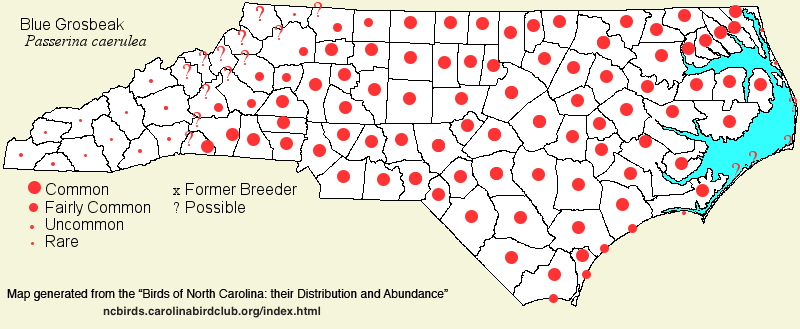 |  |
|
Blue Grosbeak - Passerina caerulea CARDINALIDAE Members: | Search Common: Search Scientific: |
|
|
|||||||
| General Comments | The Blue Grosbeak breeds across the southern half to two-thirds of the United States, and winters in the tropics. Over the past few decades, its breeding range has slowly moved northward, and over that time its overall numbers have increased somewhat in the South. It nests throughout the Coastal Plain and Piedmont of the state, but it is scarce in the mountains, as it is a "hot weather" species. It is one of the more numerous breeding birds near cropland margins, and birds will feed in cornfields and other fields of row crops (though not nesting there). Favored habitats are abandoned fields with saplings and shrubs, drier thickets, and wooded margins; it does not nest in forested areas. There are scattered winter records, but for some odd reason, there have been very few such reports in recent years, despite global warming. | ||||||
| Breeding Status | Breeder | ||||||
| NC BRC List | Definitive | ||||||
| State Status | |||||||
| U.S. Status | |||||||
| State Rank | S5B | ||||||
| Global Rank | G5 | ||||||
| Coastal Plain | Summer resident, with a few winter records. Common in summer across most of the province, but can be only fairly common and more local close to the coast. Generally uncommon breeder on coastal islands. In winter, about 6 records. Mainly mid- or late Apr to late Oct, sparingly into winter. Peak counts: | ||||||
| Piedmont | Summer resident, with about 15 winter records. Common over the eastern and central portions, and fairly common in the western portions; scarce in the foothills. In winter, very rare straggler in the eastern half of the region. Mainly mid- or late Apr to mid-Oct, sparingly into winter. Peak counts: | ||||||
| Mountains | Summer resident at low elevations; little migratory movement through the region. In summer, uncommon at low elevations, mainly in the southern half of the province, below 2,500 feet; probably more numerous in Cherokee than elsewhere. Rare to about 3,000 feet, and likely does not nest in most of the northern (north of Buncombe) mountain counties. Several were seen around Stratford (Alleghany) on 29 Jun 2014, indicating that (at least locally) it might not be rare in a few areas near the VA border. A male singing above 5,000 feet along Yellow Mountain Gap Trail (Avery) on 25-26 May 2024 was probably a wandering bird looking for a mate. Also, Pearson et al. (1959) state that there is a nesting record for "Blowing Rock (4100 ft.)", which is remarkable for the elevation, but it must be considered as an "accidental" breeder there. Mainly late Apr to mid-Oct; no winter reports. Peak counts: | ||||||
| Finding Tips |
None needed in the Piedmont and Coastal Plain. **** | ||||||
| Attribution | LeGrand[2025-05-09], LeGrand[2024-08-06], LeGrand[2024-05-15] | ||||||
| NC Map Map depicts all counties with a report (transient or resident) for the species. | Click on county for list of all known species. |
| NC Breeding Season Map Map depicts assumed breeding season abundance for the species. |  |